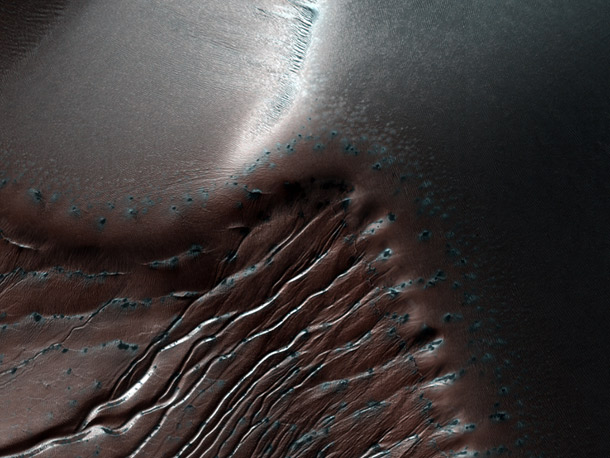Does liquid water still flow on Mars?
We know that in the distant past – like, a billion years ago – liquid water was abundant on Mars. We also know that water currently exists on Mars in the form of ice, sometimes just below the surface (where even small meteor impacts can reveal it). But can there still be liquid water flowing on Mars, even if only for a very, very short time?
Maybe. Just maybe.
 This HiRISE image shows a small region of a Martian crater named Russel (click to access much bigger versions of it). There are a lot of sand dunes in it, and as you can see in the lower left, many gullies as well. These gullies were obviously carved by something moving downslope. Sometimes, these gullies can form due to the presence of dry ice: frozen carbon dioxide, which is abundant on Mars. In the summer, as temperatures warm, the dry ice turns into a gas, dislodging material and letting it roll downhill. It’s thought that quite a few gullies on Mars are formed this way (as well as very dramatic avalanches).
This HiRISE image shows a small region of a Martian crater named Russel (click to access much bigger versions of it). There are a lot of sand dunes in it, and as you can see in the lower left, many gullies as well. These gullies were obviously carved by something moving downslope. Sometimes, these gullies can form due to the presence of dry ice: frozen carbon dioxide, which is abundant on Mars. In the summer, as temperatures warm, the dry ice turns into a gas, dislodging material and letting it roll downhill. It’s thought that quite a few gullies on Mars are formed this way (as well as very dramatic avalanches).
But these Russell Crater gullies are different. They do seem to form at higher elevations, near the tops of dunes, as you’d expect. But there are also weird dark spots near these locations, which are poorly understood. The gullies seem to be constrained in their width; they don’t get broader downslope. Mind you, these are super-hi-res images; the gullies shown here are only a few meters across, if even that! You could easily hop across them if you were strolling across the Red Planet’s surface.
The gullies do widen where two tributaries meet, which is exactly as you’d expect from flowing material. That’s probably clearer in this picture of the same region but taken at a different time:
But the really weird thing is how the gullies end. If this were just sand flowing because it was disrupted by dry ice evaporating, you’d expect to see a fan-shaped formation where the gullies terminate downslope. That’s the natural way flowing sand comes to a halt, by spreading out and forming those big triangles. But these gullies don’t do that. Instead, they just kinda stop. The gullies suddenly end in an abrupt narrowing of the trench, as if the material that’s moving is being reabsorbed by the surface underneath it.
That is certainly not what you expect from solid material like sand flowing downhill. It’s far more like the way an actual flowing liquid behaves. Because of this a team of German scientists studying this data think this may be more evidence that water can exist as a liquid on the surface of Mars, at least for short periods, time enough to flow downhill a bit. So we’re talking seconds or minutes here, not years, but still. Holy Haleakala.
[Edited to add: I neglected to mention originally that the length of these gullies has been seen to grow between the times the images were taken, meaning that whatever is flowing down these dunes is doing so right now. This isn’t some long-ago phenomenon; it happened a few weeks ago!]
Liquid water on the surface of Mars can’t stick around long; even at those low temperatures it will boil away from the low atmospheric pressure, or freeze rapidly. So having any liquid at all is really pretty amazing. But it raises lots of other questions, not the least of which are where does it come from, and why the heck is it liquid at all? You’d expect the water under the surface, if that’s what’s causing this, to be frozen; we see lots of that on Mars. So why is this liquid? Did something happen to liquify it (and it’s a pretty short list of what could do that), or is it liquid already (like in an underground aquifer or a hot spring) and just happened to break through the surface to flow for a short, glorious time?
The only way to know for sure is to keep looking. These images are a red flag for scientists, an alarm raised that we need to keep digging around, to keep our eyes open, and to pay attention to what we’re seeing. There’s a whole lot that Mars is trying to tell us. All we have to do is listen.